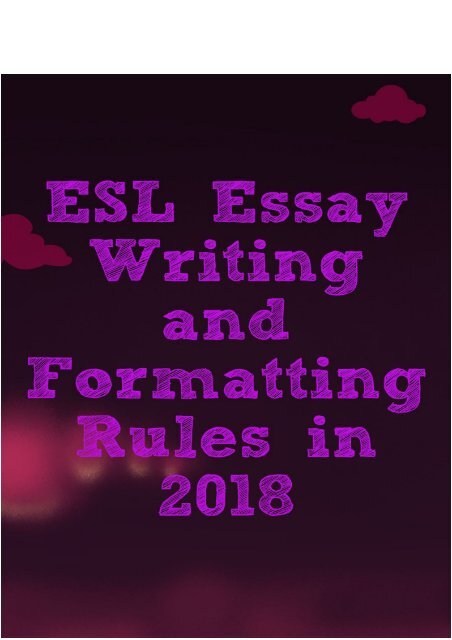ESL Essay Writing and Formatting Rules in 2018
Check this article and discover a list of new esl essay writing and formatting rules in 2018, to get more details visit site http://www.eslwriting.biz/
Check this article and discover a list of new esl essay writing and formatting rules in 2018, to get more details visit site http://www.eslwriting.biz/
You also want an ePaper? Increase the reach of your titles
YUMPU automatically turns print PDFs into web optimized ePapers that Google loves.
<strong>ESL</strong> <strong>Essay</strong> <strong>Writ<strong>in</strong>g</strong> <strong>and</strong> <strong>Formatt<strong>in</strong>g</strong> <strong>Rules</strong><br />
<strong>in</strong> <strong>2018</strong><br />
Esl essay writ<strong>in</strong>g is by no means an easy task. However, you don’t need to be<br />
Shakespeare <strong>in</strong> order to produce a high quality essay either; all it takes is some<br />
experience <strong>and</strong> follow<strong>in</strong>g a proven writ<strong>in</strong>g methodology.<br />
Successful <strong>ESL</strong> essay writ<strong>in</strong>g<br />
Today, we’re go<strong>in</strong>g to cover the most important elements of your essay <strong>and</strong> how<br />
to go about writ<strong>in</strong>g it <strong>in</strong> an optimal way (updated for <strong>2018</strong>):<br />
1. The <strong>ESL</strong> essay writ<strong>in</strong>g structure<br />
All esl writ<strong>in</strong>g assignments need to follow a predeterm<strong>in</strong>ed structure. One of the<br />
most important th<strong>in</strong>gs to keep <strong>in</strong> m<strong>in</strong>d is the 5-paragraph structure. As you<br />
might have guessed, the first paragraph should serve as an <strong>in</strong>troduction, the<br />
middle three as a body, <strong>and</strong> the f<strong>in</strong>al one as a conclusion.<br />
2. The <strong>in</strong>troduction<br />
If you’re seek<strong>in</strong>g writ<strong>in</strong>g help for esl students, the first th<strong>in</strong>g they’ll cover is the<br />
<strong>in</strong>troduction. This is where you should present your argument <strong>and</strong> announce<br />
what you’re go<strong>in</strong>g to be explor<strong>in</strong>g. It’s hard to get it right on the first go
(perhaps even the hardest part of the entire essay), especially s<strong>in</strong>ce it also needs<br />
to be designed <strong>in</strong> a way to efficiently grab the readers’ attention. It’s f<strong>in</strong>e to<br />
<strong>in</strong>clude some quotes here, as these often do a great job of spark<strong>in</strong>g some<br />
<strong>in</strong>terest.<br />
3. The body<br />
The body is the meat of the essay <strong>and</strong> it should be rich <strong>in</strong> content. It goes<br />
without say<strong>in</strong>g, but the content should also be unique to avoid any plagiarism<br />
issues (take a look at esl paraphras<strong>in</strong>g tools for help). Apart from that, the very<br />
first paragraph needs to touch upon the most press<strong>in</strong>g issue you want to discuss,<br />
<strong>and</strong> you shouldn’t be pull<strong>in</strong>g your punches.<br />
Please bear <strong>in</strong> m<strong>in</strong>d that merely cit<strong>in</strong>g is not enough at this po<strong>in</strong>t – you should<br />
be us<strong>in</strong>g citations, quotes, <strong>and</strong> references only as tools to support your argument<br />
with. If you’d like to see some examples of this, search for english essay help<br />
<strong>and</strong> there should be plenty. Any facts you list <strong>in</strong> the body section of your essay<br />
should serve to support your ma<strong>in</strong> thesis. When writ<strong>in</strong>g, make sure to stay<br />
focused <strong>and</strong> keep your tra<strong>in</strong> of thoughts <strong>in</strong> check; the content needs to flow<br />
quite well.<br />
4. The conclusion<br />
This is your last <strong>and</strong> f<strong>in</strong>al chance to tie everyth<strong>in</strong>g together <strong>and</strong> make a clos<strong>in</strong>g<br />
conclusion. It should reflect on the most important po<strong>in</strong>ts you’ve made <strong>and</strong><br />
make a strong argument that proves your orig<strong>in</strong>al thesis. It does not need to be<br />
long, s<strong>in</strong>ce it’s much more important to make every s<strong>in</strong>gle word count. If
writ<strong>in</strong>g this part ends up giv<strong>in</strong>g you trouble, you can always turn to esl writ<strong>in</strong>g<br />
help providers for assistance.<br />
5. A quick word on fonts<br />
Don’t try to be fancy <strong>and</strong> use unconventional fonts – this will do more harm<br />
than good. Stick<strong>in</strong>g to the classic Times New Roman or Arial is the safest way<br />
to go.<br />
Conclusion<br />
Before turn<strong>in</strong>g it it, take advantage of esl proofread<strong>in</strong>g services so you won’t<br />
lose po<strong>in</strong>ts due to bad grammar. Apart from that, you should now have a pretty<br />
good idea on how to approach <strong>ESL</strong> essay writ<strong>in</strong>g, <strong>and</strong> if you already have some<br />
experience as a writer, the assignment should be a piece of cake. Good luck!<br />
More <strong>ESL</strong> <strong>Essay</strong> writ<strong>in</strong>g pieces of advice<br />
available below:<br />
http://www.eslwrit<strong>in</strong>g.biz/



